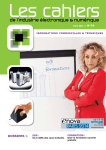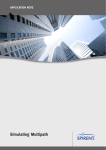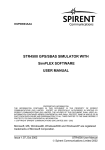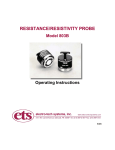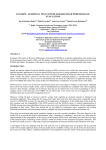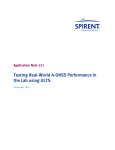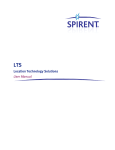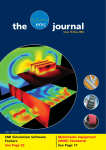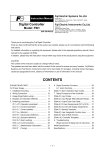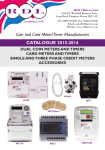Download Connecting your Simulator to your Receiver APPLICATION NOTE
Transcript
APPLICATION NOTE Connecting your Simulator to your Receiver Key issues to consider to ensure an error-free process Spirent Communications PLC Paignton, Devon, TQ4 7QR, England Web: http://www.spirent.com/positioning Tel: +44 1803 546325 Fax: +44 1803 546301 Copyright © 2011 Spirent. All Rights Reserved. All of the company names and/or brand names and/or product names referred to in this document, in particular, the name “Spirent” and its logo device, are either registered trademarks or trademarks of Spirent plc and its subsidiaries, pending registration in accordance with relevant national laws. All other registered trademarks or trademarks are the property of their respective owners. The information contained in this document is subject to change without notice and does not represent a commitment on the part of Spirent. The information in this document is believed to be accurate and reliable; however, Spirent assumes no responsibility or liability for any errors or inaccuracies that may appear in the document. SPIRENT Application Note Page 2 Contents Audience 4 Introduction 4 RF Simulation 5 Typical GPS Simulators 5 Simulator to receiver interconnection 5 Direct connection 6 Active antennas 9 Radiated coupling 12 Conclusions 14 Referenced Documents 14 SPIRENT Application Note Page 3 Audience This Application Note is for designers, developers, integrators and testers of GNSS receivers or systems, who are users of Spirent’s range of GNSS RF simulators. Introduction The transfer of RF energy from one device to another requires special consideration. The methods that must be employed are significantly different to those employed at DC. A GNSS receiver is normally connected (either permanently or via removable connection) to a suitable receiving antenna. However, when testing using a GNSS RF SPIRENT Application Note Spirent recommends you have a basic understanding of satellite navigation and RF communications principles, an awareness of RF simulation as a test method, and some familiarity with Spirent products. Simulator, this connection may need to be broken or altered in order to inject the L-band (1.5 GHz) test signals into the receiver. This Application Note discusses some of the issues relating to simulator-receiver interconnection, and highlights some common problems, which may be wrongly attributed to the receiver. Page 4 RF Simulation An RF Constellation Simulator reproduces the environment of a GNSS receiver on a dynamic platform by modelling the vehicle and satellite motion, signal characteristics, atmospheric and other effects, such that the receiver will actually navigate according to the parameters of the test scenario. By its very nature, simulation is a representation of the real world. Simulation cannot reproduce the full richness of real world conditions. A common misconception is the need to exactly replicate real world conditions for a GNSS test to be valid. However, application of representative effects via simulation is proven (over some 25 years of testing) to exercise receivers and adequately identify their limitations allowing for design centring and optimisation. More importantly, it gives complete repeatability, control and exact knowledge – down to bit level – of the signal stimulating the receiver. Typical GPS Simulators All the tests discussed in this Application Note can be performed using any of Spirent’s multi-channel simulators. Simulator to receiver interconnection There are two methods for transferring RF signals from a simulator to a device under test; direct physical connection SPIRENT Application Note This is not possible in the real world. We should look upon simulator testing as representing the real world, rather than replicating it. Continued, successful deployment of receiver designs in many applications, prove that the simulators being used for their development and verification are accurate in their implementation of the GNSS environment. Figure 1 shows the concept of simulation (using a GSS6700 simulator.) Figure 1: RF Simulation Flow For further information on Spirent’s range of Simulators, please contact your local Spirent representative, or visit www.spirent. com/positioning. (this is the most controlled method for repeatable results), or radiation. This section discusses each method, including things to be aware of. Page 5 Direct connection The 50 Ohm transmission line The industry standard method for physically interconnecting RF devices and test equipment is by the use of a transmission line with a characteristic impedance (Zo) of 50 or 75 ohms. Such transmission lines can be microstrip, stripline or coaxial inside RF devices, but are predominantly coaxial (coax) for external interconnection between test equipment. 50 Ohms is used, as it is an impedance that enables a coax cable with practical physical proportions to be used. Coax cable is considered a transmission line, because the propagation of energy along it at RF frequencies cannot be described simply as a flow of current, as at DC. Energy is propagated down the coax as an electro-magnetic wave. The coax looks like a continuation of series inductors and parallel capacitors. The characteristic impedance (Zo) of the transmission line is equal to the square root of the ratio of the line’s inductance per unit length divided by the line’s capacitance per unit length, as shown by the following formula: , where, L is the inductance per unit length, and C is the capacitance per unit length. SPIRENT Application Note The signal voltage charges each capacitor while the current charges each inductor. The charge is then transferred to the next inductor and capacitor, and so on, at the velocity of propagation (which is approaching the speed of light). Figure 2 illustrates this principle, and shows additional elements representing a realistic transmission line with losses. Figure 2: Transmission line equivalent circuit In an ideal, theoretical transmission line, all the power inputted will propagate along it and be delivered to the load. This is called “Maximum Power Transfer”. In practice, this does not happen. All real transmission lines suffer loss. Power is dissipated along the length of the line and the power delivered to the load is less than power leaving the source. At frequencies in the microwave L-band region, (as used by GNSS), this loss is significant, and can typically be tens of dB per metre. Page 6 Another problem is mismatching. For a transmission line to work efficiently, it must have a load at the end, which has the same characteristic impedance as the line. If this doesn’t happen, some of the energy will be reflected back down the line to the source. When a mismatch of impedance occurs, reflected waves will be produced and they will interact with the incident waves. The total voltage and current on the line are no longer the result of a single travelling wave from the source to the load. Instead, it is the algebraic sum of two waves travelling in opposite directions. This interaction results in standing waves. The waves remain in fixed positions along the line while they vary in amplitude and polarity. A wave of any shape can be transmitted along the line without any change of wave-shape or magnitude. SPIRENT Application Note The importance of these effects becomes apparent, particularly when connecting test equipment (such as GNSS simulators) to a device under test. The simulator output power is carefully adjusted during its alignment using a power meter, which terminates the input in precisely 50 ohms. Therefore, it is very important that the coax cable carrying the signals to the device under test is of good quality, and that its characteristic impedance is 50 ohms. Its other specifications (such as loss, phase stability and VSWR) must also be well understood, or the absolute accuracy of the simulator will be masked, and power level dependant tests may be compromised. Please refer to the user manual for your model of simulator to check the required performance for devices connected to the RF ports of the simulator. Page 7 Active antennas Many GNSS receivers use active antennas, which include an LNA. The LNA typically provides pre-amplification gain of 20 to 30 dB, and has a low noise figure, which determines the main contribution to the cascaded noise figure for the receiver. It is important that the LNA is as close to the antenna as possible, which is why it is incorporated in the same housing. The antenna and LNA are normally connected to the receiver unit by a coax cable. In order to operate the LNA, DC power is required, which is normally fed through the same coax to save having a second cable. When a receiver is connected to the output of a simulator, the antenna is removed. The DC voltage on the coax centre conductor is still present, but is not a problem because the RF output of the simulator is DC protected. However, by removing the antenna you are also removing the gain of the LNA and this needs to be compensated for. Compensation can be made using the simulator’s signal control, but this may impact the simulator’s dynamic range. The best solution is to use an LNA with the same noise figure and gain as the one in the removed antenna, on the output of the simulator. This way the simulator can remain operating in the centre of its power control range, and the receiver will have the correct signal level at its input. Figure 3 shows an LNA connected in the RF signal path. Figure 3: Simulator RF output fed through LNA to receiver Devices with optional external antenna connections Some devices (such as PDAs and pocket PCs) have, as well as a built-in antenna, a 50 ohm miniature RF connector which allows an external active antenna to be connected. Very often, the device is able to detect when the external antenna is connected, because it detects a resistance to ground of a few kilo-ohms. This enables the power supply for the external antenna (which is otherwise disabled, mainly to conserve battery power), and switches the RF input from the internal antenna to the external one. In normal operation this is fine, but if the external antenna SPIRENT Application Note connection is being used to input signals from a simulator, a problem can occur. If the simulator RF output is DC isolated (as most are), the device under test will not detect a DC resistance to ground, and will not switch its RF input to the external connection, preventing the simulator’s signals reaching the device under test’s RF front end. The solution to this problem is to introduce a DC resistance to ground into the connection between the simulator and the device under test. This can be done with a simple ‘current sink’ circuit, comprising of a couple of components on a small piece of 50 ohm microstrip circuit board. Figure 4 shows this circuit. Page 8 Figure 4: DC current sink circuit Component values The resistor, R provides the DC path to ground. The inductor (or ‘choke’), L is required to prevent the RF signal leaking to ground. The inductor needs to have an inductive reactance, XL, of approximately 1k Ω at the operating frequency, so using the formula: Where: f = the operating frequency of 1.5x109 Hz, and XL = 1000, giving us; For the resistor, we need to know the voltage of the external antenna power supply, and the nominal current. Let’s assume they are 5V and 10 mA. The resistor is simply 5/0.01 = 500 Ω (use 510 Ω). (use 100nH) The entire circuit is best placed in an RF shielded enclosure (with the connectors protruding at either end), to minimise stray RF signals. The circuit should be placed in the set-up as shown in Figure 5 The resistor and inductor are surfacemounted. 0805 or 1206 sizes are suitable for 1.5 GHz operation. Figure 5: Set-up including DC current sink circuit SPIRENT Application Note Page 9 The Monitor/Calibration or ‘MON/CAL’ port Spirent’s multi-channel simulators are equipped with a MON/CAL port. This port is used during alignment at the factory, to set the power output on the calibrated front panel RF output port. The MON/CAL port allows you to obtain the simulator’s RF signal at a level 50~60 dB higher than the front panel. This higher-power signal can be used to overcome missing LNA gain as discussed in section 5.2, or where the signal is split (and halved in power) between two receivers. The MON/CAL port must be used with caution, for the following reasons: •T he MON/CAL port is not DC isolated on earlier STR4760 series simulators, and damage to the simulator can occur if a DC block is not placed on the MON/CAL port. •T he absolute power level is not calibrated at the MON/CAL port, unlike the front panel RF output port, which will output the exact level displayed in SimGEN™. •T he receiver’s equivalent input noise will be artificially low, as the noise contribution from the antenna LNA is missing. This may result in abnormal Carrier-to-Noise (C/No) readings on some receivers navigating using signals from the MON/CAL port. Care must be taken if you are performing Time-To-First-Fix (TTFF) or sensitivity tests that involve taking C/No readings from a receiver. In these cases, the methods discussed in section 5.2 should be adopted. Care must also be taken if resistive coaxial attenuators are used. You must ensure that a DC block is used to protect these devices if the receiver under test supplies DC power to its antenna, and this cannot be switched off. This is because an attenuator appears to a DC power source, as 50 ohm resistor to ground. Without a DC block, any DC current will flow to ground via the attenuator, which may damage it. This may also damage the receiver as it may not be capable of supplying enough current. Figure 6 shows the right and wrong order of components when attenuators are used. Figure 6: Right and wrong use of resistive attenuatorsYou are advised to read Spirent’s simulator hardware manual (reference a), as it gives the performance specification and limits for the ports on each simulator type. SPIRENT Application Note Page 10 Radiated coupling Sometimes, it may not be possible to physically connect to the input of a receiver. Some devices (like mobile phones and PDAs) have built-in antennas with no external access. For these, the only way to get the RF signal from the simulator to the device under test is to radiate it. The simplest way to radiate is to connect a ½wave-length dipole antenna to the output of the simulator, and place the device under test near to this antenna. There are however, some important points to note with this simple method:• In many countries, radiation of GNSS signals is not legal. • It is not well controlled. • It is subject to interference from other sources (including the real GNSS signals). • It can potentially interfere with other systems/equipment. SPIRENT Application Note A suitable dipole antenna can be easily made, either using PCB material, or by simply separating the inner conductor from the screen by the correct length. Figure 7 shows a dimensioned drawing of a simple dipole for 1.5 GHz. Figure 7: Simple L-band Dipole Antenna •U nlike the direct connection method in 5.1, the device antenna is included, but no spatial performance tests can be carried out on it, as the RF energy is arriving from one direction, rather than different directions as per satellites in a real constellation. •S trong multipath can be experienced due to nearby RF reflective objects. These factors can all reduce the effectiveness and/or validity of tests, so a more robust method is required. Page 11 RF shielded enclosures RF radiation is a suitable method, if it is well controlled. The ideal requirement is to transfer all of the RF energy from the simulator to the device under test, with no distortion or interference. This requirement will never be met entirely, but steps can be taken to minimise problems. Placing the device under test and transmitting antenna in an RF shielded enclosure is a valid method, but enclosure must have the following attributes: • RF shielding of at least 40dB at 1.5GHz • Internal surfaces covered in suitable Radio Absorbing Material (RAM) to minimise internal reflections and multipath Enclosures like this are available in various sizes, depending on the application. For some applications, large anechoic chambers are required. Some of these chambers are large enough to completely enclose railway locomotives or aircraft, and cost millions of pounds. Other enclosures are much smaller, and fit on a bench in a laboratory. The smaller enclosures are typically referred to as TEM cells. TEM means ‘Transverse Electric Mode’ and refers to the mode of coupling within the enclosure. SPIRENT Application Note It is not possible to establish a far-field mode of propagation in smaller enclosures. GNSS typically uses Right-Hand Circular Propagation (RCHP) but this can only be established in larger anechoic chambers. For this reason, the spatial properties of a device’s antenna cannot be tested in a TEM cell enclosure. A certain amount of characterisation is required when using an enclosure. Placement of the device under test in slightly different positions within the enclosure will affect the coupling loss, even in a TEM cell, which is designed to give a consistent TEM field within the enclosure. However, this inconvenience is small compared with the problems associated with an open radiated test set-up. A typical mid-sized (2m long) TEM cell enclosure is shown in Figure 8. Figure 8: TEM cell enclosure (Image courtesy of Accelonix Ltd) Page 12 Conclusions In this Application Note, we have discussed the different methods of transferring the simulator’s RF signal to the device under test, and the problems that need to be addressed. Direct connection is always the preferred method, because it is well controlled and protected against external influences. Radiated coupling is less controlled, but is the only method available for devices with no external coaxial connection. Radiated coupling can be a reliable method, if it is carried out in an RF shielded enclosure, and well controlled. A good understanding of these methods, and the potential problems, will add integrity to your testing, and help to preserve the high fidelity inherent in the signals of a precision RF simulator. Referenced Documents a) D GP00703AAA, latest issue, Signal Generator Hardware User Manual Glossary of Terms dB DC Decibel, is a logarithmic unit of measurement that expresses the magnitude of a physical quantity (usually power or intensity) relative to a specified or implied reference level. Direct Current GNSS LNA PCB PDA VSWR Global Navigation Satellite System Low Noise Amplifier Printed Circuit Board Personal Digital Assistant Voltage Standing Wave Ratio SPIRENT Application Note Page 13 CONTACT US DAN006 ISSUE 1-02 Got a smartphone? If you have a smartphone download a QR Code reader and then point your phone camera at the QR Code to read the graphic. We are adding new content to our website on a regular basis. Bookmark this link: www.spirent.com/positioning Visit the Spirent GNSS blog, there are currently over 90 posts with 2 to 3 new posts added each week. Catch up on what’s new. www.spirent.com/Blog/Positioning.aspx Need more information? [email protected] Why not share this document? Facebook LinkedIn Twitter Technorati Google Buzz Spirent Communications Spirent Federal Systems +44 1803 546325 [email protected] www.spirent.com/positioning +1 714 692 6565 [email protected] www.spirentfederal.com Rev. 1.0 Sept 2011 Digg Delicious Reddit Stumbleupon














